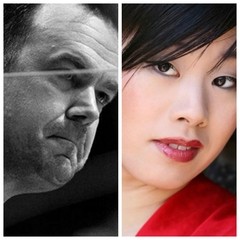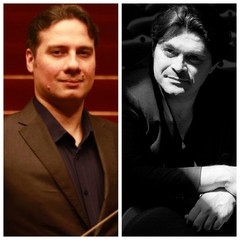|
Back
Blazing Drums, Brassy Brass New York
DiMenna Center for Classical Music
01/20/2023 - & January 21, 2023
Pierre Thilloy: Liberty (World Premiere)
Camille Saint‑Saëns: Piano Concerto No. 2 in G minor, Opus 22 (*)
Augusta Holmès: Roland furieux (US Premiere)
Candace Chien (Piano)
Matthew Aubin (*), Miguel Campos Neto (Conductors), Chelsea Symphony Orchestra

M. Aubin/C. Chien (Courtesy of the Artist/© Rebecca Fay)
“We ought to have our own music–without sauerkraut.”
Erik Satie (to Debussy)
“If Camille Saint‑Saëns had been making shell‑cases during the war, it would have been better for music.”
Maurice Ravel
With the mightiest bang on a bass drum since Verdi’s Dies Irae circus drum, the Chelsea Symphony started their “French remembrance” concert last night. It was more than the bass‑drum thwack–actually four forte fortissimo thwacks. It continued for massive drums and strings. The ensemble, now in its 17th year, had more than its share of trumpets, drums, fanfares and revelries for their bookend pieces.
Where, in this “French Remembrance” concert were our so‑Gallic harps? Our smooth Ravel fairy‑tales? Our precious Debussy glissandi? Well, the Chelsea Symphony did have an oh‑so‑suave Saint‑Saëns Piano Concerto in the middle. But otherwise, Chelsea’s two fine conductors did their chores with all the energy that other music deserved.
That percussive opening piece, Liberty, was written by Pierre Thilloy, who was in attendance here. The title could have equally been called War or Vengeance, since the first half was loud, fierce, a powerful anthem on four downward chromatic notes simulating and moving with the drum. Granted Liberty can be achieved by force of arms, so obviously Mr. Thilloy was ready to give us the martial strife.
This was always in the background until Concertmaster Nicholas Pappone’s violin solos. They were not saccharine, they delved into minor second dissonances. So both Mr. Pappone and the Chelsea Symphony offered a more conciliatory vision of Liberty. Perhaps a questionable vision as well. A 19th Century composer would have finished with a euphonious ensemble performing with a major‑key hymn of joy. A Twentieth-Century Boulezian would have created Liberty by allowing the instruments to play whatever aleatory sounds they wanted.
Pierre Thilloy seemed to say in his music that Liberty can’t be defined, and we should be at liberty to understand it as we wished.

M. Campos Neto/P. Thilloy
Miguel Campos Neto, the Brazilian‑born co‑founder and an Artistic Director of the Chelsea Symphony, finished the concert with an equally blazing work by the 19th Century French‑Irish composer Augusta Holmès. Ms. Holmès is unknown in America, and probably for good reason, since her work seemed derived from Richards Wagner and Strauss, without much originality from either.
Then again her subject, from the 16th Century crazy novel Orlando furioso, would difficult enough for a half‑hour symphonic poem. Lully, Vivaldi and Handel needed a few hours to depict Charlemagne’s hero, wandering madly from France to Ethiopia to China in search of his girlfriend Angélique. So Ms. Holmès effort at brassy patriotism, with equine galloping strings and punctuated brass, was a worthy effort.
Then again, the bucolic middle movement, the romance between the Asian Princess Angélique and the Saracen Knight Médor, was an essay in boredom. Berlioz had the good sense to add a cor anglais for his country scene. Ms. Holmès let the cello them wander on...and on.
Conductor Matthew Aubin took the podium for a more staid French work, Camille Saint‑Saëns’ popular Second Piano Concerto. Staid isn’t quite the right word. Saint‑Saëns’ unquestioned genius, living from the era of Mendelssohn to the age of Elliott Carter turned out hundreds of works. He was happy with his style, never changed, was unquestionably both inspired and efficient.
This Piano Concerto needs a variety of moods, from the crashing opening arpeggios to the frothy middle movement and Presto finale. Soloist Candace Chien was technically able in even the most difficult measures. Lacking, though, were those changes of mood so necessary to make this work move.
Her opening was that of a sedate Bach solo, the remainder of the movement advanced with all the right tempos, but rarely that contrast of grace and ferocity, The final two bumptious movements were given all the right velocity by Mr. Aubin, and Ms. Chien plowed through the notes with well‑practiced proficiency.
Harry Rolnick
|